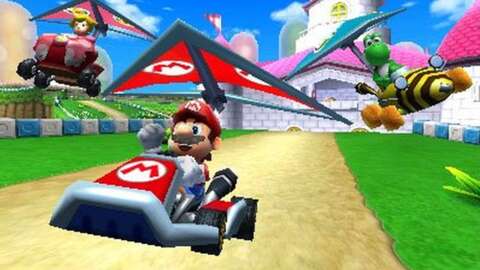History is built in layers. This was the key concept Firaxis kept in mind as it planned Civilization VII, the next entry in its long-running 4X strategy series. Civilizations are not static; they rise and fall, and new cultures take over and build on top of them. With Civ VII, Firaxis is aiming to make its playable journey through history more dynamic than ever, capturing how civilizations themselves change and adapt over time.
One of the keys to this new approach is a trisected campaign, splitting the historical drama into three distinct “Ages:” Antiquity, Exploration, and Modernity. Each of these roughly tracks to moments and advancements that are familiar for longtime Civ fans, but introducing these eras is aimed at providing better pacing and a sense of culmination for each era, as securing objectives will help determine your options as you move from one Age into the next.
“Players love to play the Antiquity phase of Civ VI,” executive producer Dennis Shirk told GameSpot. “They might play until things get a little difficult or crowded, and they’re like, ‘Okay, I’m done. I’m going to start over and play this way.’ There are other players that like to play the whole way through. There are other players that like to try to play the whole way through, but by the time they realize what they want to do or how they want to play or how the world is unfolding, it might be too late for them to grab victory. What [we] wanted to do with the Age system is to break this up into chapters. Not to break up the whole experience in terms of Stone Age to Space Age, but a way for a new player to set their own little milestones. You notice that you get to choose the direction, the flavor, that you want to play.”
There are four legacy paths to victory, representing the classic Civ victory conditions: Science, Economy, Military, and Culture. The objectives for each will change based on the Age, and some alternative victory paths have been folded into this new structure. The Religion path, for example, used to be an outright victory condition itself. In Civilization 7, it doesn’t play a major role in the Antiquity period but becomes very important for a Culture path during the Exploration age. Completing objectives in each Age will grant you a boost going into the next one.
That means that from the earliest parts of your journey through time, you can start laying the groundwork for your victory by steering in that direction. A series of mini-quests will yield rewards as you progress, giving you headwinds going into the next phase. But crucially, you aren’t locked into just one path. You can pursue multiple paths and open up even more opportunities as you progress through the later phases, if that’s how you choose to play.
Progressing through the eras is also crucial to the other massive change in Civilization VII: namely, that you are no longer bound to a single civilization throughout the entire game. You’ll pick your and civ at the start of the game, but then as you transition into the Exploration and Modernity phases, you’ll choose a new civilization with its own unique traits. Which civs you gain access to depends on a complex flow chart of criteria that you fulfilled during your era–for example, certain civilizations that adequately master horseriding will then be able to transition to Mongol civilization during the Exploration era.
“It’s a way to play different civs at the height of their power,” Shirk said. “No longer do I have to play a civ and wait until I’m in the Modern Age until the Zero Fighter unlocks for me to have something special. Each culture that erupts is a culture that you’re playing at the height of its power. When you’re playing in these different chapters, you get new toys to play with along with the old stuff that you’ve pulled along for the ride. You’re going to have that Roman Forum in the middle of your city when you’re playing your Exploration game because it’s what you built before, and you still have it there and it’s still generating what it’s supposed to generate.”
Crucially, your leader will remain the same throughout the different Ages, but that also means that leaders are decoupled from their respective civilizations. For the first time in the series, you’ll pick your leader independent of their civilization, on top of the civ changes at the start of each Age. We weren’t told how many combinations this creates, and it’s not clear if Firaxis itself has nailed down an exact number. The team seems especially excited to see how the hardcore Civ community explores these options, because the meta will no longer be particular civilizations against each other, but an almost incomprehensible number of mix-and-match combinations.
For all the promise this system holds, though, I wasn’t able to see it come to fruition for myself. Our hands-on demo was a new game starting from the Age of Antiquity, with a limited selection of leaders and civs to choose from as a starting point. That means I wasn’t able to see the transition to a new Age, including selecting a new civilization based on my accomplishments through the Antiquity era.
What I did see, though, was the way Civilization VII uses these systems to gently guide players toward specific goals that align with their preferences in a remarkably organic and readable way. I had chosen the Roman Empire to start, aiming to maximize my Culture influence and noting that it had the best passive bonuses of my selections. As I progressed through several dozen turns, forming relationships with neighboring civilizations and building up my cache of Wonders, the mini-quests helped maintain my awareness of how my actions would impact the path I chose. I’m confident that, with a little more time, I would have completed my Culture milestone for the Antiquity period and then moved into the Exploration phase with a leg up on that victory condition.
“Different ages certainly lean into certain areas. Exploration is all about exploration. It’s about crossing oceans. It’s about making the world bigger,” Shirk said. “There’s different directions you’re going to want to go in, but that’s great about it. That’s the cool thing with these containers that they put together with Ages, is that each one has a new set of systems to play with. Each one has that new civ, each one has new gameplay systems.”
That’s not to say that pursuing a cultural victory was a walk in the park. As I doggedly pursued being the most-influential civilization, the surrounding cultures were a good deal more militaristic. It quickly became apparent that I couldn’t get by on influence and alliances alone–I was going to need a standing military to protect me from the civs that simply refused to accept my cultural influence as a show of peace. And whether for military conquest or simply protecting your hard-earned Wonders, there’s another important new mechanic in Civilization VII: Commanders.
Commanders are special units that give a bonus radius around them, and they can form up armies around them to create a single cohesive unit. They earn XP and can level up, which grants them access to more-advanced commands. But they aren’t fighters on their own, like the Hero Units from games like Warcraft 3 or StarCraft. Instead, they act more as a mobile hub for your armies–similar to Great Generals in Civilization 6–directing coordinated attacks and enabling specialized movement tactics.
“We wanted to change the way that we handle our promotions in the game so that units are a little bit squishier, more disposable, so that you could have these big, massive feel-good battles with other players,” game designer Carl Harrison said. “Whereas in previous entries, if you had that unit with a ton of promotions and it got lost, that felt really bad. Now you have this Commander that stacks up all the promotions and applies them to everybody else. If that frontline unit does get destroyed in battle, it’s not the end of the world for you.”
Shirk added that players of Civ VI might recognize the pain point of trying to move a huge army through a narrow mountain pass, and recognizing opportunities for refinement was another big driver behind the new Commander units.
Ben Franklin faces off against Emperor Ashoka
“That was one of the big drivers too. We’re like, ‘No, let’s have the Commander, who will group in that five, six units.’ They move faster. If there’s a unit camped out in that pass, they can use an overrun ability that the Commander has on the group, plop them out of the way and then deploy on the other side. It just makes the basics of maneuvering a lot more fun, or grouping armies together and just stacking them in a defensive place for use later, as a container of awesome for when you need to use it.”
And mindfulness about past Civilization games runs throughout Civ VII, even as recently as the various expansions for the last Civilization game. Shirk mentioned that natural disasters, for example, are included in this game because the feature was such a fan-favorite from Gathering Storm.
“Those past games influence us a lot,” Shirk said. “Not only in a good way, but in the way that the reality when we came into development of this one, of knowing that our fans know exactly what we’re going to make and how we’re going to do it and in what order it’s done. That’s where [we were] like, ‘No, not this time. We’re going to switch this up and make them look at the game with fresh eyes this time, I think.'”
And based on my time, Civilization VII really does demand that fresh-eyed approach. Even if I wasn’t able to experience changing civs mid-campaign, the impact of those changes are apparent throughout, even from the very start of the game. It gives new goals to strive for, clear sign-posts to follow, and a mind-boggling degree of complexity and combinations for old-time Civilization pros to experiment with. Like history itself, Civilization games are built in layers–and this one appears to be radically advancing from Exploration to Modernity.




